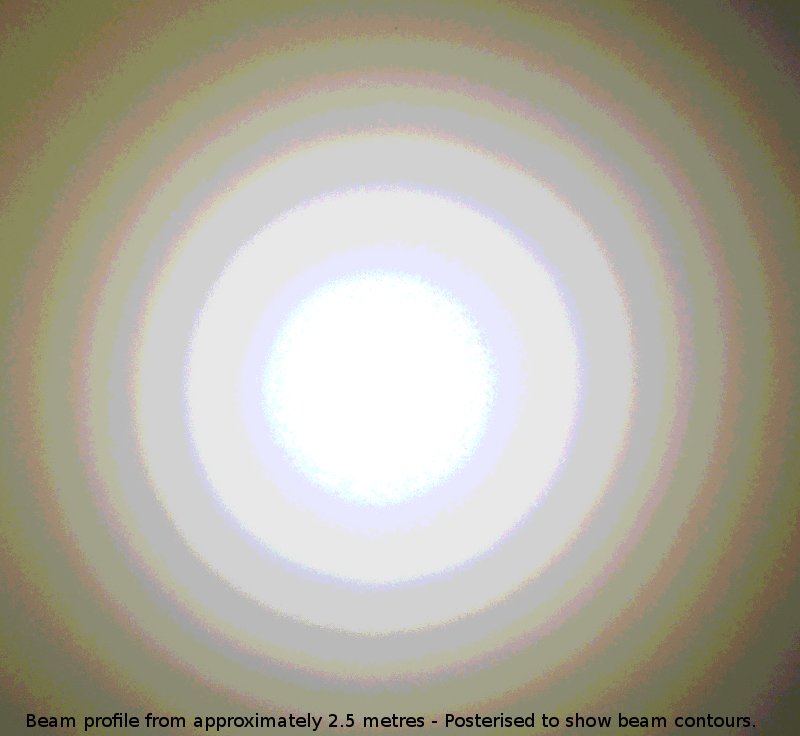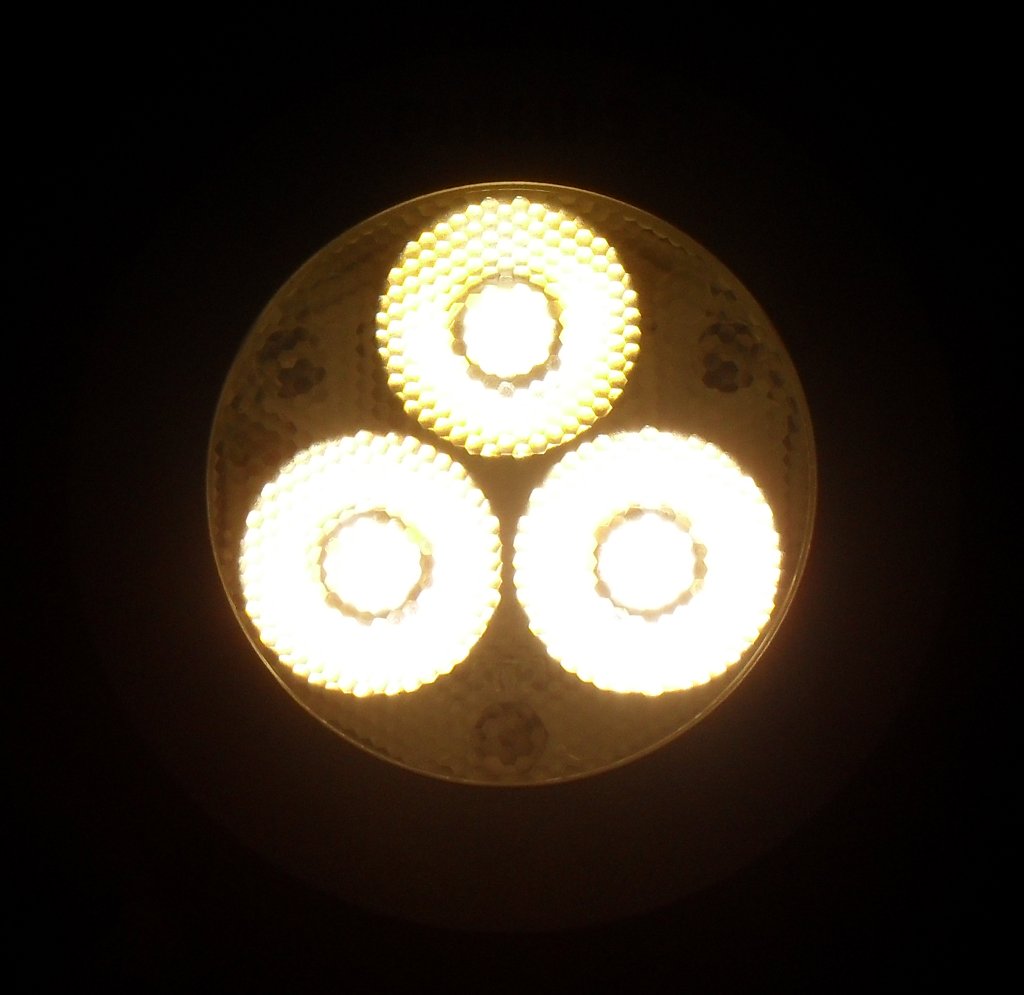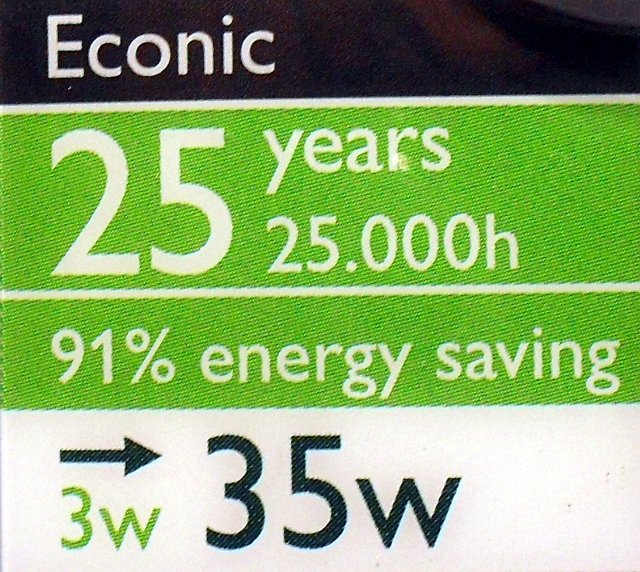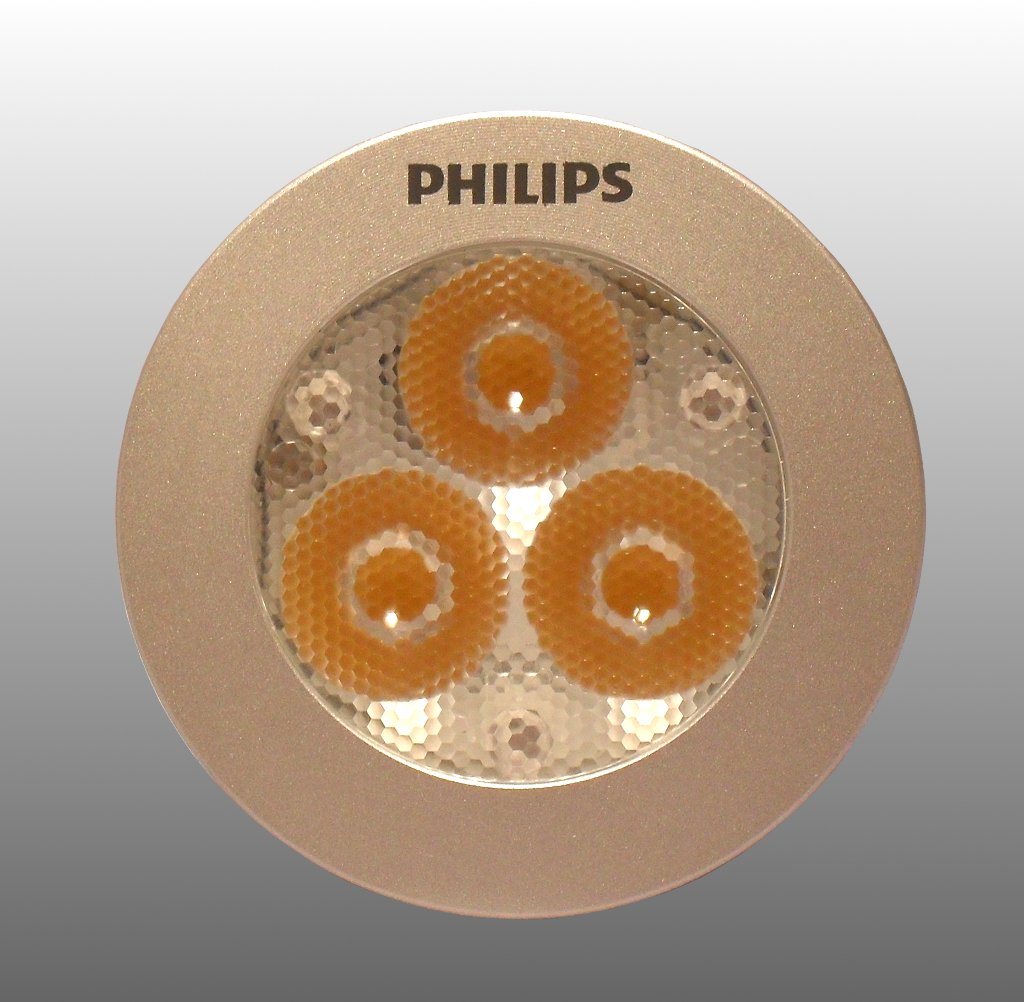
| Manufacturer: | Philips |
| Model: | Econic 3W GU10 25 Degree 3000K LED. |
| Application: | General Lighting - Directional lighting. |
| Wattage: | 3W |
| Width (max): | 53mm |
| Length: | 50mm |
| Tube Length: | N/A |
| Bulb/Tube material: | Plastic/Metal |
| Colour Temperature: | 3000K At Beam Centre |
| Peak output wavelength: | Broadband |
| Total light output: | Not stated. |
| Rated lifetime: | 25,000 hours. |
| Cap: | GU10 |
| Operating voltage: | 230-240V AC |
| Operating current: | 35mA (Due to very low power factor (0.35) |
| Warmup/restrike time: | None |
| Cost (original): | £19.98 (From B&Q Aberdeen Garthdee, August 2010) |
| Place of manufacture: | China |
| Date of manufacture: | March 2010 - Date code 0C on lamp. |
| Lamp Status: | Working, new in packaging. |
So here we
go, we have finally reached the point where high power LED's are
starting to poach traditional incandescent territory.
ES50 lamps such as this have been a very popular type of halogen
incandescent lamp both in the domestic and commercial markets since
their invention in the closing years of the 1990s. In the
domestic setting they have been popular for a number of applications;
but recessed down lighters and directional workspace lights like the one
on my desk are probably some of the most common. They have been
popular in the commercial market for display lighting and similar use
in recessed fixtures as in the domestic market.
Compact fluorescent versions of these lamps have been popping up for a
few years now - in fact I've been using a 7W 4000K CF version in my
desk lamp for a year or so - however these have a few drawbacks.
Firstly is that many ES50 lamps have quite narrow beam angles - whereas
the fluorescent versions due to the large surface area of the source
really come in flavours of "180 degree flood" or "slightly less than
180 degree flood" - and that's it. Due to the very compact tube
in fluorescent terms, they tend to run very hot as well - which in turn
means that they tend to start out very dim. The fact that the
tube is actually inside the same enclosure as the ballast results in
that in turn running very hot - the entire assembly of this one tends
to stabilise at nearly 70 deg C - that can't be good for the ballast.
LED's do address some of these problems. Firstly there's the beam
angle - LED's are point sources, as such directional beams are
something that they are very well suited to with the correct
optics. This particular lamp has a rated beam angle of 25
degrees, far tighter than anything any CFL product can manage.
The warm up time issue is of course non-existent, with full light output
being achieved instantly. The temperature issue is one which is
likely to be somewhat less of an issue here simply due to the lower
power levels involved - however it is still an issue.
LED's do not like heat - they are at their most efficient and will last
their best at low temperatures - plus at higher temperatures (beyond
their designed specification) their spectral properties tend to drift
somewhat. If the LED is getting that hot though, you will
probably already be witnessing a substantial drop in output however, so
it's not likely to be a major issue in designs like this. If
there is one major headache when it comes to high power LED designs, it
is the thermal management. If you look at the higher power
versions, they tend to have impressive looking finned metal heat sinks
built into the base to help dissipate the heat. This is because
while you're not dealing with that much actual heat than CFLs in power
terms in a lamp like this - LED's need to be kept at a lower
temperature than CFLs do. While this particular lamp does not
have any huge fins or anything - the substantial weight suggests to me
that a good percentage of that white section is in fact a
heat sink. The whole thing does get quite toasty (isn't that a
technical term!), seeming to stabilise at around 55 deg C.
The one complaint I think I have about this lamp is that while the
*overall* colour of the light is all but indistinguishable from
incandescent - it's that it isn't entirely uniform throughout the
beam. It's a nice pure 3000K a the beam centre, but drops
considerably to a very yellow - I'd say around 2300K at the
edges. In many applications this is really going to be quite
visible, and may be seen as unsatisfactory - it would certainly bug me
somewhat if using it as a task light for my desk, at least
initially. This may be less of an issue if the lamp is to be used
in recessed ceiling fixtures - but for task lights and display lighting
it's something which I think Philips need to put some more thought
into. Bit of a shame really - as it's a good effort on all other
counts.
It is a bit expensive - on the same note though, if you looked at CFLs
when they were just starting to appear on the market, they weren't far
off the same price in relative terms. Once this sort of lamps
start to gain a foothold in the market properly I would expect to see
price levels dropping quite considerably. These aren't likely to
drop to the price of incandescent ES50's, but at the same time -
they're going to last a heck of a lot longer! Unlike CFLs as
well - these LED retrofits will undoubtedly handle physical abuse very
much better - so you're not likely to kill your £20 lamp by whacking
your head on the lamp when standing up from the desk - I've taken out
more than one incandescent doing that! Have killed a CFL by
dropping it before too.
One other item of note is the power factor of this device. This
is not something which a domestic customer really needs to worry about
- as domestic electricity meters only measure real power - taking no
note of any reactive load. The meters used on commercial premises
however are more complex, and do in fact measure not just the real
power consumed in watts, but the apparent power in VAR (volt amp
reactive). What this means is effectively that the power drawn by
this lamp is not entirely in phase with the 50Hz sine wave of the power
supply - the result of this is that while it is drawing a total of 3W
of real power - it appears for all intents and purposes, to be drawing
8W of power. As I've indicated above - domestic meters in the UK
don't take into account reactive power (conventional magnetic
fluorescent ballasts (without power factor correction capacitors which
some are fitted with), fridge motors and many other low power things
with switch mode power supplies in like laptop and phone chargers also
have lousy power factors) - so you don't need to worry - as far as your
meter is concerned, this lamp uses 3W. If you're planning on
using a few hundred of these throughout your office complex however,
you might want to see whether you'd be getting quite the energy cost
saving you were looking for though! You'll still see a
considerable saving I imagine with a cut from 35W to 3W - just that the
increased reactive component may have an effect on the overall figure.
These are early, tentative steps into the market of main steam lighting
for LED technology, just as was the case for CFL technology 26 years
ago...As with that before it though, it shows great promise. I
will be watching with great interest to see where things go from here.

Philips Econic 3W GU10 25 Degree 3000K LED Lamp - General overview

Philips Econic 3W GU10 25 Degree 3000K LED Lamp - Modified image to show beam profile from approximately 2.5 metres

Philips Econic 3W GU10 25 Degree 3000K LED Lamp - Showing rear of lamp and cap

Philips Econic 3W GU10 25 Degree 3000K LED Lamp fitted to desk lamp illuminating my workstation

Philips Econic 3W GU10 25 Degree 3000K LED Lamp - Detail of lamp face while alight

Philips Econic 3W GU10 25 Degree 3000K LED Lamp - Detail of lamp face looking into beam while alight

Philips Econic 3W GU10 25 Degree 3000K LED Lamp Packaging

Philips Econic 3W GU10 25 Degree 3000K LED Lamp - Detail of text on packaging

Philips Econic 3W GU10 25 Degree 3000K LED Lamp - Detail of LED optics

Philips Econic 3W GU10 25 Degree 3000K LED Lamp - Held in hand to show relative scale

Philips Econic 3W GU10 25 Degree 3000K LED Lamp Output Spectra

Philips Econic 3W GU10 25 Degree 3000K LED Lamp - Detail of text printed on lamp base
![]()
This lamp added to the Virtual Display Shelf on the 14th September 2010 at 22:59.
References: Lamp packaging and markings only.
Acknowledgements: None.
This page last updated:
18th June 2023: Changes to page formatting to improve readability on mobile devices and some background code changes to improve search engine behaviour.